
|
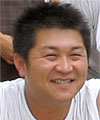
Futoshi Mano
|
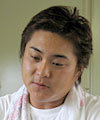
Shigeru Mano |
Featured Breeder
Futoshi Mano, Shigeru Mano
(Dainichi Koi Farm) |
In the long history of nationwide contests, the Showa Sanshoku, the overall championship in 1991, became known as the remarkable Dainichi Showa. Reproducing its bloodline, the Mano Brothers, Futoshi, Hiroshi, and Shigeru, are now putting their heart and soul towards another overall victory. A Tosai Dainichi Showa possess a lot of elements in becoming Tategoi, so there is much expectation to how it will change.
|
This business was started by our father, so it was just natural to have Koi around us since we were born. At the moment we only breed Gosanke (three most popular Nishikigoi: Kohaku, Showa Sanshoku and Taisho Sanshoku), but by carrying down the genealogy created by our father and also by creating our own, we want to create Koi that has strong individuality, that is, a Koi with “Dainichi” features. For example in a Showa, it would be interesting to create a Koi with black that only Dainichi can develop. It isn’t much fun if all the breeders’ Koi were alike. Niigata is the birthplace of Nishikigoi, and that’s why the breeders should have sophisticated techniques and should implement breed improvement. It is important for each breeder to develop unique characteristics of their Koi, and we believe the Koi lovers would enjoy that. In fact, in recent Koi shows, you can tell that Showa’s black is becoming stronger and bolder.
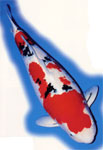 We are fortunate that our father left us with good parent Koi. It is easy to tell the parent of a category-prize-winning Showa. We can also distinguish a Koi born from a parent Koi which has won the Kokugyo Award. However, we cannot depend only on the Koi that our father left us because when they reach 20 years of age or so, their hatching rate decreases and body shape becomes irregular. So we have to create our own parent Koi. Needless to say, the female Koi is important, but we have put in lots of efforts in developing the male as well; this is a Dainichi characteristic. Those parent Koi now are about to turn 4 and 5 years, so were are looking forward to them; we believe that creating exquisite Koi in the new generation is the breeders’ role. We are fortunate that our father left us with good parent Koi. It is easy to tell the parent of a category-prize-winning Showa. We can also distinguish a Koi born from a parent Koi which has won the Kokugyo Award. However, we cannot depend only on the Koi that our father left us because when they reach 20 years of age or so, their hatching rate decreases and body shape becomes irregular. So we have to create our own parent Koi. Needless to say, the female Koi is important, but we have put in lots of efforts in developing the male as well; this is a Dainichi characteristic. Those parent Koi now are about to turn 4 and 5 years, so were are looking forward to them; we believe that creating exquisite Koi in the new generation is the breeders’ role.
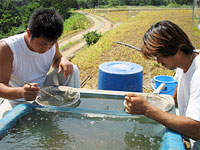 Body conformation is important but we focus on the quality of color as well, and as a result of that we get well-shaped Koi with great beni and black qualities. We want to create a Dainichi Koi that, at a show, will grab people’s eyes and will not let go. To do so, we need to refine our sensibility as a breeder. Body conformation is important but we focus on the quality of color as well, and as a result of that we get well-shaped Koi with great beni and black qualities. We want to create a Dainichi Koi that, at a show, will grab people’s eyes and will not let go. To do so, we need to refine our sensibility as a breeder.
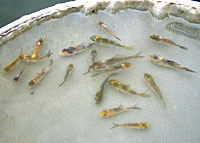 You might look at a bad-looking Koi and say that it will become a Tategoi in the future; that’s sensibility. Sensibility varies among individuals, so it is hard to say who is correct until time goes by. That is the challenging but interesting part. Perhaps we can say this because we are breeders, but the future of an unborn Koi is an exciting and unknown world. You might look at a bad-looking Koi and say that it will become a Tategoi in the future; that’s sensibility. Sensibility varies among individuals, so it is hard to say who is correct until time goes by. That is the challenging but interesting part. Perhaps we can say this because we are breeders, but the future of an unborn Koi is an exciting and unknown world.
We really enjoy breeding Koi. It is even more fun when it is born from a good parent. Once you start raising your own Koi, you just can’t stop. For the first year you keep them in mud ponds, and then you go onto ikeage. Once you see your Koi, you can’t quit. Ikeage in autumn is the best part. That’s why we can keep going. We get up early in the morning to do tsunahiki. We have 70 ponds in Niigata and select and sort the Koi 3 times a year, which means that we have to do tsunahiki 210 times a year. But we enjoy this because the better we do it, the better our Koi become. We believe the most important thing is to raise them with much love; all of the Niigata breeders cherish their Nishikigoi and give them deep affection: the reason for being able to create wonderful Nishikigoi.
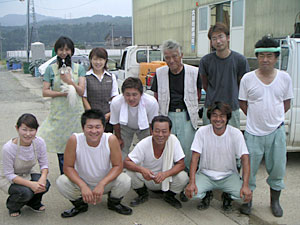 We hope Koi lovers in all parts of the world will nurture our Nishikigoi with much love because what we want the most is for our Koi to be raised by people who truly love them. Nishikigoi are living creatures, so we want them to be raised in an environment which gives each Koi to express themselves. We’ve seen that in any part of the world, Koi lovers who truly love Nishikigoi closely observe their Koi, take good care of the lauter tubs, control the water, and handle diseases very well. We hope Koi lovers in all parts of the world will nurture our Nishikigoi with much love because what we want the most is for our Koi to be raised by people who truly love them. Nishikigoi are living creatures, so we want them to be raised in an environment which gives each Koi to express themselves. We’ve seen that in any part of the world, Koi lovers who truly love Nishikigoi closely observe their Koi, take good care of the lauter tubs, control the water, and handle diseases very well.
As each breeder aspires for different goals in terms of size and shape, the Koi lovers can have their own way of enjoying them, too. If you don’t have a pond, you can keep them indoor in an aquarium. But no matter how you keep them, we want you to take good care of them so they will live long because they are living creatures. We believe that there should be a community where we, breeders, and Koi lovers can directly exchange information to improve ourselves, and we believe INPC is an asset in that regards.
|
|







